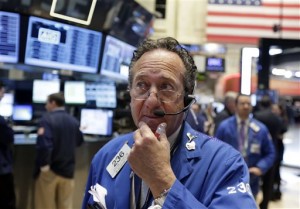
In this March 14, 2014, file photo, trader Steven Kaplan works on the floor of the New York Stock Exchange. US stocks rebounded on Thursday from the previous Federal Reserve-sparked losses, as markets turned to favorable US economic data for inspiration. AP PHOTO/RICHARD DREW
NEW YORK—US stocks rebounded on Thursday from the previous Federal Reserve-sparked losses, as markets turned to favorable US economic data for inspiration.
The Dow Jones Industrial Average finished up 108.88 points (0.67 percent) at 16,331.05.
The broad-based S&P 500 advanced 11.24 (0.60 percent) to 1,872.01, while the tech-rich Nasdaq Composite Index rose 11.68 (0.27 percent) to 4,319.29.
Traders put behind them Wednesday’s mixed signals on the timing of interest-rate hikes from Fed Chair Janet Yellen, as weekly jobless claims data came in at a promising level and the Conference Board’s Index of Leading Indicators and the Philadelphia Fed’s manufacturing index both solidly beat Wall Street estimates.
Besides a reconsideration of Yellen’s remarks, said David Levy on Kenjol Asset Management, “the other major driver to the market today was the economic data.”
The data shows “a slow but steady trend higher for the economy,” he said.
Big gainers included AT&T, up 3.4 percent, as it announced that it would start taking orders of the Samsung Galaxy 5S phone.
Microsoft moved 2.7 percent higher, in part in anticipation of the announcement that it will release an Office software suite tailored for rival Apple’s iPads.
Banks also were strong ahead of the post-closing bell release of the results of the Federal Reserve’s annual stress tests.
All but one of the 30 leading bank holding companies showed they had the capital strength to withstand a severe economic crisis; only Zions Bancorp did not beat the minimum capital threshold.
Bank of America gained 2.8 percent, JPMorgan Chase 3.1 percent, Wells Fargo 2.6 percent, and Citigroup 2.6 percent.
Some key tech stocks topped the losers list, with Facebook giving up 1.9 percent, Amazon down 1.1 percent and Apple down 0.5 percent.
Apparel retailer Guess plunged 3.4 percent after releasing a disappointing profit outlook.
Bond prices were mixed. The yield on the 10-year US Treasury rose to 2.78 from 2.77 percent on Wednesday, while the 30-year dipped to 3.66 percent from 3.67 percent. Bond prices and yields move inversely.